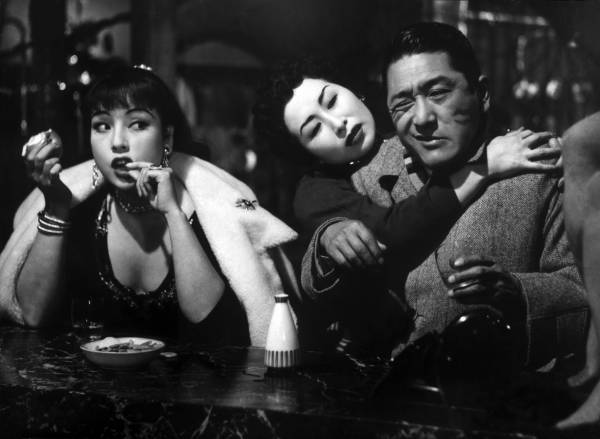STREET OF SHAME (AKASEN CHITAI) (Kenji Mizoguchi, 1956)
Museum of the Moving Image
35th Ave. at 36th St., Astoria
Saturday, May 3, free with museum admission of $12, 7:00
Series runs May 2 – June 8
718-777-6800
www.movingimage.us
 Made the same year Japan passed a major anti-prostitution law, Kenji Mizoguchi’s final film, 1956’s Street of Shame, is a brutally honest depiction of the decidedly unglamorous life of a group of courtesans at a Tokyo brothel. “Yoshiwara has been here three hundred years,” the Mamasan (Sadako Sawamura) says early on to a police officer. “Does an unnecessary business last so long?” Originally titled Red-Light District, the black-and-white film features an outstanding cast of women playing desperate geisha with serious family and financial problems that lead them to the embarrassment of trying to physically force men off the dark, dank street and into their rooms. Hanae (Michiyo Kogure) has to deal with aging, a baby, and a suicidal husband, Yumeko (Aiko Mimasu) doesn’t want her son to know what she does to earn money to attempt to give him a decent life, Yorie (Hiroko Machida) thinks a husband in a faraway village will gain her longed-for freedom, Yasumi (Ayako Wakao) has become a loan shark to her coworkers, and young Mickey (Machiko Kyō) is quick to share her opinions about the other women but not so quick to catch on to the debasement she is lowering herself to. The protofeminist director of such previous works as Sisters of the Gion, Osaka Elegy, Women of the Night, and The Life of Oharu as well as the brilliant two-part samurai epic The 47 Ronin, Mizoguchi spent much of his career — which included more than seventy films in thirty-three years, up to his death in 1956 at the age of fifty-eight — making films about the exploitation of women, partly influenced by having seen his sister sold into prostitution by their father. It’s a shame that Street of Shame, one of Mizoguchi’s best, also turned out to be his last, but what a way to go. Street of Shame is screening May 2 as part of the Museum of the Moving Image’s five-week tribute to the master auteur — who made more than eighty films, less than half of which still exist — which continues through June with the above-mentioned works as well as Ugetsu, Sansho the Bailiff, Utamaro and His Five Women, The Story of the Last Chrysanthemums, and A Woman of Rumor.
Made the same year Japan passed a major anti-prostitution law, Kenji Mizoguchi’s final film, 1956’s Street of Shame, is a brutally honest depiction of the decidedly unglamorous life of a group of courtesans at a Tokyo brothel. “Yoshiwara has been here three hundred years,” the Mamasan (Sadako Sawamura) says early on to a police officer. “Does an unnecessary business last so long?” Originally titled Red-Light District, the black-and-white film features an outstanding cast of women playing desperate geisha with serious family and financial problems that lead them to the embarrassment of trying to physically force men off the dark, dank street and into their rooms. Hanae (Michiyo Kogure) has to deal with aging, a baby, and a suicidal husband, Yumeko (Aiko Mimasu) doesn’t want her son to know what she does to earn money to attempt to give him a decent life, Yorie (Hiroko Machida) thinks a husband in a faraway village will gain her longed-for freedom, Yasumi (Ayako Wakao) has become a loan shark to her coworkers, and young Mickey (Machiko Kyō) is quick to share her opinions about the other women but not so quick to catch on to the debasement she is lowering herself to. The protofeminist director of such previous works as Sisters of the Gion, Osaka Elegy, Women of the Night, and The Life of Oharu as well as the brilliant two-part samurai epic The 47 Ronin, Mizoguchi spent much of his career — which included more than seventy films in thirty-three years, up to his death in 1956 at the age of fifty-eight — making films about the exploitation of women, partly influenced by having seen his sister sold into prostitution by their father. It’s a shame that Street of Shame, one of Mizoguchi’s best, also turned out to be his last, but what a way to go. Street of Shame is screening May 2 as part of the Museum of the Moving Image’s five-week tribute to the master auteur — who made more than eighty films, less than half of which still exist — which continues through June with the above-mentioned works as well as Ugetsu, Sansho the Bailiff, Utamaro and His Five Women, The Story of the Last Chrysanthemums, and A Woman of Rumor.
